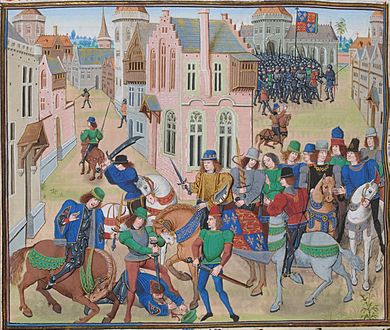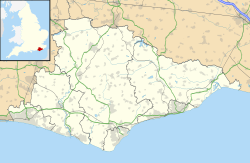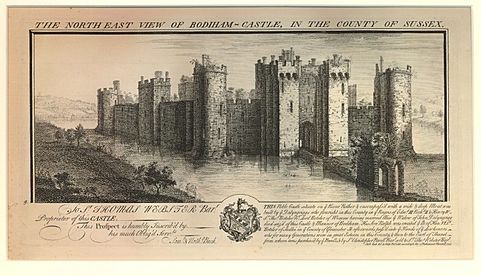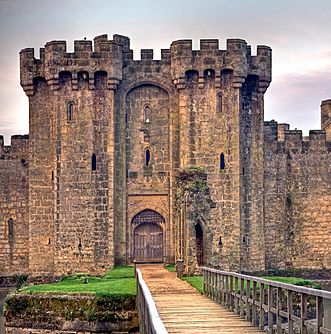Bodiam Castle facts for kids
Quick facts for kids Bodiam Castle |
|
|---|---|
| Bodiam, East Sussex, England | |
 |
|
| Coordinates | 51°00′08″N 0°32′37″E / 51.0023°N 0.5435°E |
| Grid reference | grid reference TQ785256 |
| Site information | |
| Owner | National Trust |
| Condition | Ruins |
| Site history | |
| Built by | Sir Edward Dalyngrigge |
| Materials | Sandscript stone |
| Demolished | Post English Civil War |
| Battles/wars | English Civil War |
|
Listed Building – Grade I
|
|
| Official name | Bodiam Castle |
| Designated | 3 August 1961 |
| Reference no. | 1044134 |
Bodiam Castle is a cool 14th-century castle in East Sussex, England. It's famous for being surrounded by a wide moat (a deep, wide ditch filled with water). Sir Edward Dalyngrigge, a knight, built it in 1385. He got permission from King Richard II to build it. The main reason was to protect the area from French attacks during the Hundred Years' War.
Bodiam Castle has a square shape, which is called a quadrangular plan. It doesn't have a central tower (called a keep). Instead, all its rooms are built around the outer walls and inner courtyards. The castle has towers at its corners and entrance, topped with crenellations (the notched tops of walls, like teeth). The way it's built, with its details and its setting in a watery landscape, shows it was designed to look impressive as well as for defense. It was the home of the Dalyngrigge family and the center of their land.
Over time, the castle was passed down through different families. During the Wars of the Roses, a big fight between two royal families, Bodiam Castle was almost attacked. But it seems to have given up without much fighting. The castle was taken by the king but later given back to its owners.
By the time of the English Civil War in 1641, the castle belonged to John Tufton, 2nd Earl of Thanet. He supported the King, and the castle was partly taken apart to prevent it from being used against Parliament. It became a beautiful ruin. Later, in 1829, John 'Mad Jack' Fuller bought it and started to fix it up. Other owners, like George Cubitt, 1st Baron Ashcombe and Lord Curzon, continued the restoration work. Today, Bodiam Castle is a protected historic site. The National Trust has owned it since 1925, and it's open for everyone to visit.
Contents
Why Bodiam Castle Was Built

Edward Dalyngrigge was a younger son in his family. This meant he didn't inherit his father's lands. So, he had to make his own money. By 1378, he owned the land of Bodiam because he married into a family that owned it. From 1379 to 1388, Edward was an important person in Sussex.
When he asked the king for permission to build a castle, the Hundred Years' War had been going on for almost 50 years. This was a long conflict between England and France. Edward Dalyngrigge was one of many Englishmen who went to France to earn money as mercenaries. These were groups of soldiers who fought for whoever paid them the most. Edward made enough money this way to build Bodiam Castle. He came back to England in 1377.
After a short peace, fighting between England and France started again. In 1377, Richard II became king. England and France were fighting for control of the English Channel. There were raids on both coasts. Parliament decided to spend money on defending England's south coast. Edward Dalyngrigge also helped stop the Peasants' Revolt in 1381, a big uprising in England.
In 1385, a large French fleet gathered across the English Channel. People in southern England were very scared. Later that year, Edward Dalyngrigge was given permission to build a castle on his land. This permission was called a "licence to crenellate."
Building the Castle
Edward Dalyngrigge's permission from King Richard II allowed him to make his old house stronger. But he decided to build a brand new castle instead. Most of the castle was built at the same time. This suggests it was built quickly, probably because of the threat from the French. Building stone castles was usually very expensive and took a long time.
Edward Dalyngrigge was busy in France from 1386 to 1387. So, he was probably not there for the first few years of the castle's building. Bodiam Castle became his main home and the center for managing his lands. We don't know exactly when it was finished, but it was likely before 1392. Edward Dalyngrigge died in 1395, so he didn't get to spend many years in his completed castle.
After Edward, his son John Dalyngrigge inherited the castle. John was also favored by the King. He died in 1408. Since he had no children, the castle eventually passed to his cousin, Richard Dallingrigge. When Richard died without children in 1470, the castle went to Sir Roger Lewknor. This is how Bodiam Castle moved from the Dallingrigge family to the Lewknor family.
Sir Thomas Lewknor, Roger's son, supported one side in the Wars of the Roses. When Richard III became king in 1483, Lewknor was accused of treason. A force was sent to attack Bodiam Castle, where Lewknor was. We don't know if the attack actually happened. But it's thought that Lewknor gave up without much fighting. His property was taken away, but when Henry VII became king in 1485, Bodiam Castle was given back to Lewknor. The Lewknor family owned the castle for many more years.
By the start of the English Civil War in 1641, the castle belonged to John Tufton, 2nd Earl of Thanet. He supported the King's side. To help pay fines against him, Tufton sold Bodiam Castle in 1644. The castle was then partly taken apart. This was done to stop it from being used as a stronghold by the King's supporters. The barbican (an outer defense), bridges, and buildings inside the castle were dismantled.
Bodiam Castle as a Ruin and Its Restoration
After the Civil War, Bodiam Castle became a ruin. It was left in this state for a long time. In the mid-1700s, people started to visit it because it was seen as a beautiful old ruin covered in ivy. This was part of a new interest in old buildings and Gothic style.
In 1829, John 'Mad Jack' Fuller bought the castle. He started to repair parts of it. He fixed one of the towers and added new gates. He also removed a small house that had been built inside the castle. Fuller probably bought the castle to stop its previous owners from taking it apart even more.
Later, in 1849, George Cubitt, 1st Baron Ashcombe bought the castle. He continued the repairs. He had a detailed survey of the castle done in 1864. He also fixed the tower in the southwest corner, which had almost fallen down. At that time, people liked ruins covered in ivy, so the plants were not removed, even though they could damage the stone.
Lord Curzon bought Bodiam Castle in 1916. He believed such a special place should be protected. He started a big project to restore the castle in 1919 with architect William Weir. The moat, which was about 5 feet deep, was drained. About 3 feet of mud and silt were removed from it. During this work, the original foundations of the bridges to the castle were found.
They also cleared plants, fixed stonework, and brought the castle's floors back to their original level. A small building was built to be a museum for things found during the excavations and a home for a caretaker. Lord Curzon gave Bodiam Castle to the National Trust in 1925.
The National Trust continued the restoration. They added new roofs to the towers and the gatehouse. More excavations happened in 1970, and the moat was drained again. Bodiam Castle has also been used in movies and TV shows. It appeared in Monty Python and the Holy Grail (1975) and Doctor Who episodes like The King's Demons (1983) and Robot of Sherwood (2014).
Today, Bodiam Castle is a Scheduled Monument and a Grade I listed building. This means it's a very important historic site that is protected. It's open to the public, and many people visit it every year. Many historians think Bodiam "represents the popular ideal of a medieval castle."
Castle Design and Features
Location and Landscape
The castle's location was supposedly chosen to protect England's south coast from French attacks. However, experts have noted that Bodiam Castle is quite far from the medieval coastline. This suggests its location might have been chosen for other reasons too.
The area around Bodiam Castle was changed when the castle was built. This was done to make it look more beautiful. Bodiam is seen as one of the best examples of how a landscape was designed to make a castle stand out. The water features were once very large, but now only the moat remains. The moat is roughly rectangular and gets its water from several springs.
A moat can stop attackers from reaching the castle walls. But at Bodiam, it also made the castle look bigger and more impressive. The moat is now seen more as a beautiful feature than a strong defense. The way you approach the castle, through the moat and other ponds, was not direct. This gave visitors time to admire the castle's splendor.
The castle sits in the middle of the moat. The back entrance (called the postern gate) would have been connected to the moat's south bank by a drawbridge and a long wooden bridge. The main entrance on the north side is now connected by a wooden bridge. But originally, there were two bridges: one from the main entrance to an island in the moat, and another from the island to the west bank. The island in the moat is called the Octagon. It had a garderobe (a medieval toilet), which suggests there might have been a guard there. The castle's 28 toilets drained directly into the moat, which would have been like an "open sewer."
Outside and Entrance
Bodiam is a quadrangular castle, meaning it's roughly square-shaped. This type of castle, with a central courtyard and buildings along the outer walls, was common in the 14th century. Bodiam Castle is considered one of the best examples of this type of castle that still exists.
There are round towers at each of the four corners. There are also square towers in the middle of the south, east, and west walls. The main entrance is a gatehouse with two towers on the north side of the castle. There's a second entrance at the back, through a square tower in the middle of the south wall. The towers are three stories high, taller than the main walls and the buildings inside the castle.
In front of the main gatehouse was a barbican, an outer defense. Not much of it is left today. The gatehouse itself is three stories high. It used to be connected to the barbican by a drawbridge. The top of the gatehouse has machicolations (openings for dropping things on attackers). The gatehouse is the only part of the castle with these openings for defense. The other walls and towers have windows for living, not for fighting.
Inside the gatehouse passage, there were originally three wooden portcullises (heavy grilles that could be lowered). The ceiling of the passage has murder holes. These were likely used to drop objects on attackers or to pour water to put out fires.
Above the main gate, there are three carved coat of arms. These represent the families connected to Edward Dalyngrigge: his wife's family (Wardeux), his own family (Dalyngrigge), and his mother's family (Radynden).
Inside the Castle

- A: Household apartments
- B: Chapel
- C: Chamber
- D: Great chamber
- E: Lord's hall
- F: Buttery
- G: Pantry
- H: Kitchen
- I: Retainer's hall
- J: Retainer's kitchen
- K: Possible anteroom
- L1: Possible service rooms
- L2: Possible stables
- M: North-east tower
- N: East tower
- O: South-east tower
- P: Postern tower
- Q: South-west tower
- R: West tower
- S: North-west tower (and prison)
- T: Gatehouse (with guard rooms to left and right)
- U: Inner causeway
- V: Outer barbican
- W: Outer causeway
While the outside of Bodiam Castle is mostly still standing, the inside is mostly ruins. The buildings inside the castle were built along the outer walls. But enough remains to figure out what the castle looked like. The castle was divided into separate living areas. There were spaces for the lord and his family, important guests, soldiers, and servants.
The south side of the castle had the great hall, kitchens, and other related rooms. The great hall was the main social area where the lord would entertain guests. It was as tall as the outer wall. Next to the great hall were the pantry and buttery. The buttery stored ale and wine, and the pantry held supplies for the kitchen. The kitchen was also very tall to help keep it cool from the cooking fires. In the southwest tower, there was a well for water.
Along the east wall, there was a chapel, a hall, and an antechamber. The chapel area sticks out a bit further into the moat. South of the chapel was where the lord and his family lived. These buildings were two stories high with a basement.
Along the west wall, there was another hall and kitchen. These were probably for the household's servants. This "retainers' hall" would have been darker than the great hall and didn't have a fireplace.
East of the main gatehouse was a two-story building with a basement. The basement was likely for storage, and the upper floors were for living. The purpose of the buildings on the west side of the north area is not clear. They might have been stables, but there are no drains usually found in stables. The tower in the northwest corner had a toilet and fireplace on each of its three upper floors.
See also
 In Spanish: Castillo de Bodiam para niños
In Spanish: Castillo de Bodiam para niños
- Bodiam, Eastern Cape, a town in South Africa named after the Castle
- Castles in Great Britain and Ireland
- Kenilworth Castle – another impressive castle with large water defenses
- List of castles in England






